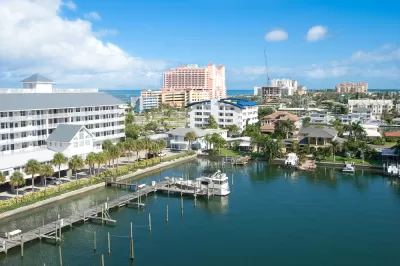The Charter of the New Urbanism favors infill development, yet new urbanists sometimes oppose infill, especially in historic urban areas. This post speculates on why that might be the case.

The Charter of the New Urbanism states: "We stand for the restoration of existing urban centers" and "Appropriate building densities and land uses should be within walking distance of transit stops, permitting public transit to become a viable alternative to the automobile." So one might think that new urbanists would favor infill development that adds density to existing urban neighborhoods served by public transit.
But I have found on my new urbanist listserv that new urbanists my age sometimes to favor NIMBY (Not In My Back Yard) housing policies- that is to say, they tend to oppose new housing in urban areas. Why? I don't have a simple, easily verifiable explanation. I do, however, have a few speculative ideas.*
First of all, new urbanists’ interest in historic preservation can conflict with pro-infill policies. The work of Jane Jacobs, a major source of new urbanist thought, focused on protecting existing neighborhoods from “urban renewal” schemes that made cities more automobile-oriented. In addition, new urbanists have emphasized the ugliness of sprawl: for example, new urbanist writer James Howard Kunstler still has an “eyesore of the month” page on his website, and I see lots of posts attacking modern architecture on my new urbanist liserv. So new urbanists are, I think, likely to favor preservation of older buildings generally and to favor exclusion of all but the best new architecture. If nothing is demolished and ugly architecture is outlawed, obviously there will be fewer new buildings. My view is somewhat different: a focus on historic preservation made sense when city neighborhoods faced a high risk of desertion or of physical destruction. But today, I am more interested in spreading the blessings of urban life to more people, even if some ugly modern architecture gets built as a result.
The close relationship between new urbanism and historic preservation may affect where urbanists are most likely to oppose new housing. In my limited experience, new urbanists are most skittish about new housing in wealthy, historic neighborhoods - unlike social justice-oriented progressives who worry that new housing in poor neighborhoods will lead to gentrification, but do not oppose new housing in rich urban areas.
Second, new urbanists do not always appreciate economics. The intellectual firepower for market urbanism and YIMBYism tends to come from economists, who have shown how restrictions on housing supply are in part responsible for high housing prices. But because urban economists are sometimes pro-sprawl, some new urbanists tend to discount economists as readily as some right-wingers discount climate science.
Third, many new urbanists tend to be on the political Left, which means they tend to blame the world's ills on capitalists and capitalism, just as right-wingers tend to blame the world's ills on government regulation of business. Since public housing is politically toxic in most of the United States, most new housing tends to be built by private developers, that is to say, capitalists. And in expensive cities, this housing tends to be occupied by rich people, who also tend to be capitalists. So it seems to me that people who believe wealthy capitalists are too powerful are likely to be hostile to housing that might be created by or for capitalists.
Fourth, most of the people I know from new urbanist meetings tend to be middle-aged and geographically stable. And if you are fifty-something and geographically stable in the United States, you probably bought a house or condo at least a decade or two ago. And if you own a house, you probably want that house to become more expensive every year so that if you ever sell it, you can make a big profit. So most of my fifty-something urbanist friends have an interest in housing becoming more expensive, not less expensive. As a result, they may be less likely to support policies designed to hold down median housing costs and rents. (Of course, this attitude may conflict with progressive support for public housing; progressive urbanists tend to support public housing, but since new public housing is almost never built in the United States we may never know how many of these progressives will support public housing in their own neighborhoods.)
*Some people reading this might argue that anti-housing arguments are simply correct, and that my friends who believe these arguments are simply wiser than I. I have responded to such arguments in many other posts and articles, and thus will not respond in this one.

Alabama: Trump Terminates Settlements for Black Communities Harmed By Raw Sewage
Trump deemed the landmark civil rights agreement “illegal DEI and environmental justice policy.”

Planetizen Federal Action Tracker
A weekly monitor of how Trump’s orders and actions are impacting planners and planning in America.

The 120 Year Old Tiny Home Villages That Sheltered San Francisco’s Earthquake Refugees
More than a century ago, San Francisco mobilized to house thousands of residents displaced by the 1906 earthquake. Could their strategy offer a model for the present?

In Both Crashes and Crime, Public Transportation is Far Safer than Driving
Contrary to popular assumptions, public transportation has far lower crash and crime rates than automobile travel. For safer communities, improve and encourage transit travel.

Report: Zoning Reforms Should Complement Nashville’s Ambitious Transit Plan
Without reform, restrictive zoning codes will limit the impact of the city’s planned transit expansion and could exclude some of the residents who depend on transit the most.

Judge Orders Release of Frozen IRA, IIJA Funding
The decision is a victory for environmental groups who charged that freezing funds for critical infrastructure and disaster response programs caused “real and irreparable harm” to communities.
Urban Design for Planners 1: Software Tools
This six-course series explores essential urban design concepts using open source software and equips planners with the tools they need to participate fully in the urban design process.
Planning for Universal Design
Learn the tools for implementing Universal Design in planning regulations.
Clanton & Associates, Inc.
Jessamine County Fiscal Court
Institute for Housing and Urban Development Studies (IHS)
City of Grandview
Harvard GSD Executive Education
Toledo-Lucas County Plan Commissions
Salt Lake City
NYU Wagner Graduate School of Public Service





























